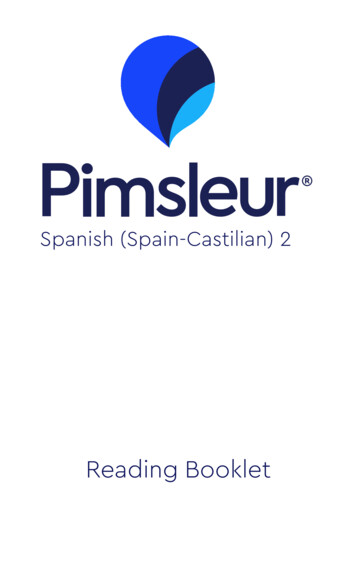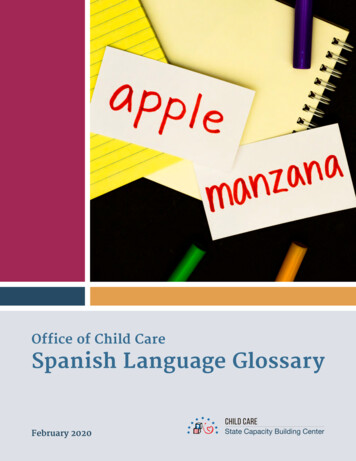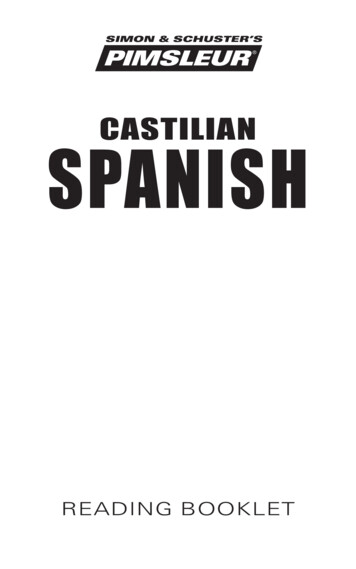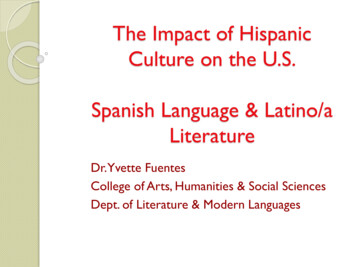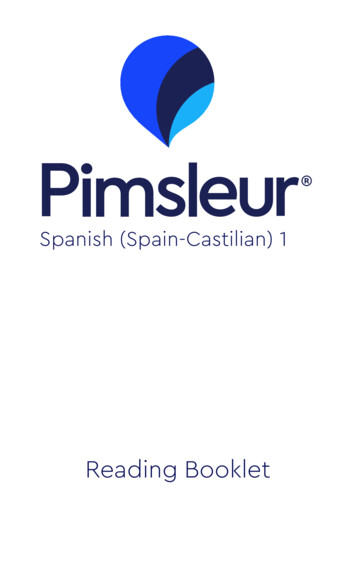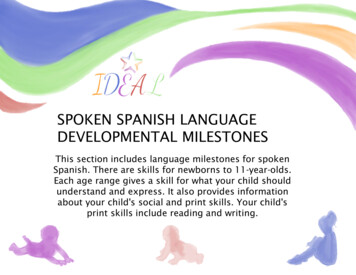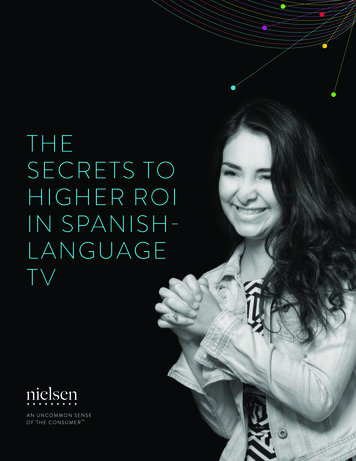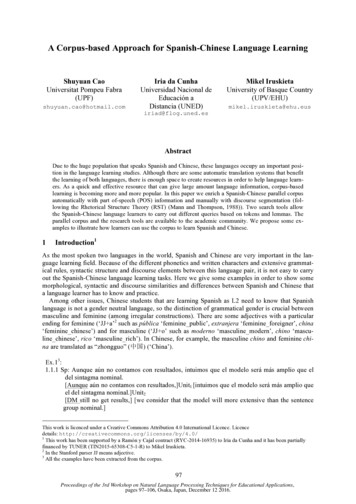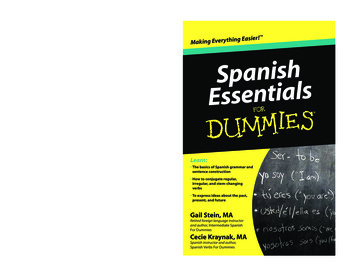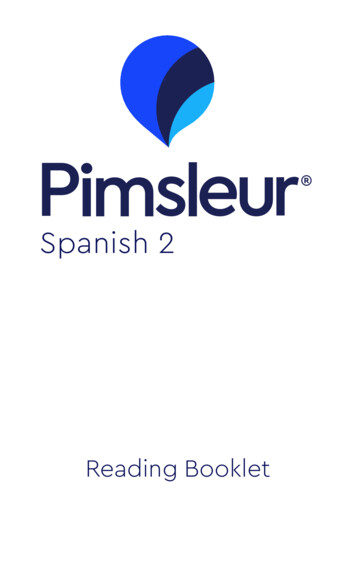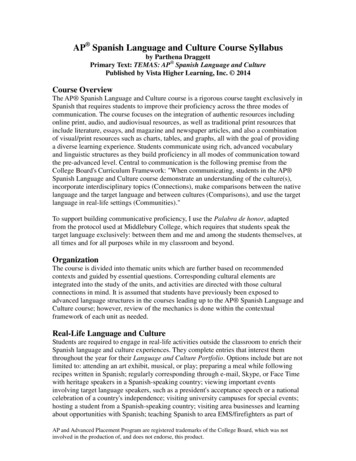
Transcription
AP Spanish Language and Culture Course Syllabusby Parthena DraggettPrimary Text: TEMAS: AP Spanish Language and CulturePublished by Vista Higher Learning, Inc. 2014Course OverviewThe AP Spanish Language and Culture course is a rigorous course taught exclusively inSpanish that requires students to improve their proficiency across the three modes ofcommunication. The course focuses on the integration of authentic resources includingonline print, audio, and audiovisual resources, as well as traditional print resources thatinclude literature, essays, and magazine and newspaper articles, and also a combinationof visual/print resources such as charts, tables, and graphs, all with the goal of providinga diverse learning experience. Students communicate using rich, advanced vocabularyand linguistic structures as they build proficiency in all modes of communication towardthe pre-advanced level. Central to communication is the following premise from theCollege Board's Curriculum Framework: "When communicating, students in the AP Spanish Language and Culture course demonstrate an understanding of the culture(s),incorporate interdisciplinary topics (Connections), make comparisons between the nativelanguage and the target language and between cultures (Comparisons), and use the targetlanguage in real-life settings (Communities)."To support building communicative proficiency, I use the Palabra de honor, adaptedfrom the protocol used at Middlebury College, which requires that students speak thetarget language exclusively: between them and me and among the students themselves, atall times and for all purposes while in my classroom and beyond.OrganizationThe course is divided into thematic units which are further based on recommendedcontexts and guided by essential questions. Corresponding cultural elements areintegrated into the study of the units, and activities are directed with those culturalconnections in mind. It is assumed that students have previously been exposed toadvanced language structures in the courses leading up to the AP Spanish Language andCulture course; however, review of the mechanics is done within the contextualframework of each unit as needed.Real-Life Language and CultureStudents are required to engage in real-life activities outside the classroom to enrich theirSpanish language and culture experiences. They complete entries that interest themthroughout the year for their Language and Culture Portfolio. Options include but are notlimited to: attending an art exhibit, musical, or play; preparing a meal while followingrecipes written in Spanish; regularly corresponding through e-mail, Skype, or Face Timewith heritage speakers in a Spanish-speaking country; viewing important eventsinvolving target language speakers, such as a president's acceptance speech or a nationalcelebration of a country's independence; visiting university campuses for special events;hosting a student from a Spanish-speaking country; visiting area businesses and learningabout opportunities with Spanish; teaching Spanish to area EMS/firefighters as part ofAP and Advanced Placement Program are registered trademarks of the College Board, which was notinvolved in the production of, and does not endorse, this product.
their service for the Sociedad Honoraria Hispánica, and more. Students must provideacceptable evidence of their engagement as described in the Language and CulturePortfolio Guidelines.In addition, I organize opportunities for my students to provide after school Spanishlessons to all elementary schools in Jackson Local Schools as part of their service to theSociedad Honoraria Hispánica. Whenever possible and a request is made, I also arrangefor students to tutor or act as classroom aides for Spanish-speaking students at nearbyelementary schools or to help their parents to interpret school communications. Throughthe above activities, students learn early on how their ability to use Spanish for real-lifecommunication in the community is valued.A Tool for Students Within the Thematic Units Explored:FUENTES AUTÉNTICAS/ORIGINALES: MIS EXPERIENCIAS Y EVALUACIONESThis is an ongoing interpretive communication assignment, with 14 entries turned inmonthly and as previous summer work, which continuously supports all thematic units. Iuse a two-part document: the first section of two pages with instructions, themes,contexts, and essential questions to consider, and the second part consisting of two logsheets for students to document their analysis and reflection. As such, students routinelyconnect to authentic resources outside the classroom that incorporate themes andrecommended contexts, as well as pondering essential questions. Once the log sheets ortablas are returned, I extend the interpretive assignment to interpersonal, face-to-face,whole class discussions to reflect further on the topics while integrating new vocabulary.This provides an extra opportunity for making cultural comparisons as we do in real lifewhen discussing world happenings and events. I have also shared this resource on theAP Spanish Language and Culture Community Site under Resources.Al estudiante:Para completar los dos lados de la tabla, es importante que escojas una variedad detemas para ganar una experiencia muy diversa y para aprender vocabulario temáticonuevo. A continuación verás los seis temas de AP , además de los temas secundariospara extender tu análisis y reflexión. Refiere a estos temas constantemente paraenriquecer tu experiencia. Es imprescindible escoger fuentes de todos los temas ycontextos. Evaluaré también tus conclusiones y tu análisis del contenido de cada fuente.Usa mi sitio de red para buscar enlaces útiles si prefieres, o busca por tu propia cuentaen Internet.Fecha¿Cuántotiempopasé?FUENTE: (el enlace oEl títuloperiódico)completo del¿Auditiva/Escrita?artículo,noticiero ovideo2Tema yLo que aprendí sobre VocabularioContextoel tema onuevo y(T1C1,acontecimiento/definiciones/T3C5, etc.)evento (2–3 frasesexplicacionescompletas con mien españolanálisis/evaluación alconsiderar laspreguntas esenciales)
Unidades temáticas, comunicación y cultura:These units are totally organized and based on the themes, recommended contexts, andessential questions of the Curriculum Framework. I also focus on integrating the sixprimary learning objectives of effective communication as I prepare students for the AP Spanish Language and Culture Exam in May.In addition, culture is central to content as we explore products, practices, andperspectives of various countries. Students are guided to develop a deeper understandingof what the people of a particular culture believe and how they view the world. They alsomake constant comparisons between Spanish-speaking communities of the world andtheir own home culture in preparation for the presentational speaking exam task.It is also important to note that, although this syllabus is structured as studying onethematic unit at a time, we are in fact integrating aspects of many themes and contexts aswe explore real life. There is an inherent interconnectedness among the six thematicunits; they do not exist in isolation. A good example of this can be found in the CollegeBoard Curriculum Module, El arte: ventana y espejo, which I co-authored and plan toalso use with my students.Moreover, this interwoven nature of the themes is even more obvious as we use theInternet to delve into everyday world events and news through Spanish language websitesof organizations and foundations. This is real life: using the lens of the Internet to viewwhat is happening in the world and discussing the plethora of news and events amongourselves. As we do this, we naturally synthesize through comparing and contrasting,evaluating, analyzing, making predictions, inferring, and drawing conclusions. For thispurpose, I have a fully developed class website that provides students with links to suchresources from throughout the Spanish-speaking world to bring the world into view.Basic Unit DesignThis course organization is based on TEMASwhich is totally built on authentic resourcesthat not only provide the major content of the thematic units and contexts, but which alsopresent students with a plethora of cultural content through which to explore products,practices, and perspectives of the Spanish-speaking world. TEMAS is the primaryresource or anchor for the course, very aligned and written in concert with the guidelinesand explanations in the Curriculum Framework. All units begin with Preguntasesenciales and are also structured to include six contextual lessons, each reflecting arecommended context of the Curriculum Framework. By both starting and ending withthe essential questions, backward design is easily accomplished, thinking first of what itis that I want the students to know and be able to communicate about, as we exploreauthentic materials within Spanish-speaking cultures of the world in which we live.3
Each contextualized lesson or Contexto includes: Puntos de partida to activate prior knowledge and get students thinking about thecontext. A Desarrollo del vocabulario section with contextualized vocabulary preparationactivities. Authentic Lecturas that include all genres, as well as maps, tables, and graphs.Each Lectura contains a Sobre la lectura information section, Palabras clave,Estrategias for reading, Antes de leer and Después de leer activities andassessments that present students with multiple opportunities to develop theirinterpretive, interpersonal, and presentational communication skills. Mostauthentic materials are accompanied by authentic photos and other graphics tosupport comprehension. Authentic Audios that include interviews, narratives, and news reports. Each isproceeded by a Palabras clave, an Introducción information section, Estrategiasfor listening, Antes de escuchar, Mientras escuchas, and Después de escucharactivities and assessments that present students with multiple opportunities todevelop their interpretive, interpersonal, and presentational communication skills. Conexiones culturales, with more authentic resources and websites for students touse to explore the context from the perspective of various Spanish-speakingcommunities of the world. A very important element of each of these sections is aPresentación oral: comparación cultural activity that mirrors the new task on theexam itself and gives students a plethora of tools for comparing various aspects oftarget language communities and their own community. These sections are rich invisuals to provide an even greater look into the culture.In addition, each thematic unit or Tema includes: Léxico sections that present students with thematic vocabulary appropriate to thecontexts studied, through a meaningful, contextualized process. Estructuras sections integrated appropriately to reinforce challenginggrammatical structures encountered within the authentic readings and audios, andtaught in meaningful contexts. Ortografía y puntuación sections that provide students with explanations andpractice activities. A Cinemateca section with a cortometraje that presents students with an authenticaudiovisual resource synthesizing the unit's theme. Each includes: Estrategias,Palabras clave, Sobre el corto, Antes de ver, Mientras mira,s and Después de veractivities and strategies that aid in comprehension and provide opportunities forpracticing all modes of communication as students make connections to thetheme. A final, Integración del tema essay section where students return to the unit'sPreguntas esenciales, think more deeply about the theme and topics explored, andresearch as necessary, in preparation for writing an ensayo. There is a differenttype of ensayo per theme, such as: Ensayo de comparación, Informe deinvestigación, Ensayo narrativo, Ensayo argumentativo, and Ensayo de opinión.Each Integración del tema section includes Antes de escribir, Escribir el4
borrador, and Escribir la versión final sections, as well as Estrategias appropriateto the ensayo genre.Exam Work Text:And, to provide more authentic resources and practice with the tasks for the AP Spanish Language and Culture Exam in May, we will also use the following testpreparation work text:Frisancho, Jorge, AP Spanish Language and Culture Exam Preparation, VistaHigher Learning, 2014I will use the advance organizers to search by Tema/Contexto, while also consideringwhere my students need more practice with Primary Learning Objectives and examtasks, as needed throughout the thematic units.Unit OneTema 1: Families and Communities / Las familias y las comunidadesContextualized Chapters or Contextos: Education Communities / Las comunidades educativas Social Networking / Las redes sociales Human Geography / La geografía humana Customs and Values / Las tradiciones y los valores Global Citizenship / La ciudadanía global Family Structure / La estructura de la familiaEssential Questions: ¿Cómo se define la familia en distintas sociedades? ¿Cómo contribuyen los individuos al bienestar de las comunidades? ¿Cuáles son las diferencias en los papeles que asumen las comunidades y las familiasen las diferentes sociedades del mundo?Connections also to the themes of: Los desafíos mundiales, La vida contemporánea, Labelleza y la estética, Las identidades personales y públicas, La ciencia y la tecnologíaLecturas auténticas:« Tiempo de Juego»En esto creo: « Educación», por Carlos Fuentes«Facebook, el monstruo de las dos cabezas»«Centroamérica y las redes sociales»«La situación de los pueblos del lago Atitlán»«30 años de cultura de mall»El niño y la niebla, por Rodolfo Usigli«Homenaje a las madres de la tradición artesana»5
Más selecciones auténticas de audio:«Tocar y luchar»«Jóvenes y uso de las redes sociales»«Basura: un problema en aumento»«CULTURA: Garífuna»Cinemateca auténtica: «Ella o yo»Highlights of an example Contexto from Tema 1Here, I provide a fairly complete sample Contexto that students will explore, showingauthentic resources presented, a wide variety of strategies and activities, focus on culturalproducts, practices, and perspectives, real-world tasks, and multiple opportunities forstudents to develop their communication skills from the intermediate-mid to thepre-advanced range in all modes as described in the front matter of my syllabus. Thisexample is based on Tema 1, Contexto 4 from TEMAS, pages 48–61.Contexto 4: Las tradiciones y los valores1. Puntos de partida (interpersonal speaking): Begin by exploring the Puntos de partidato get students thinking critically within the context and to start activating priorknowledge and cultural experiences that they have had. Read and discuss in small-groupinterpersonal format; then share out:Las tradiciones y los valores son elementos básicos de una cultura y se encuentranestrechamente relacionados. Usualmente, ambos se transmiten de generación engeneración, y las tradiciones que uno elige preservar reflejan un sistema de creencias ovalores. ¿Cuáles son los principales factores que influyen en la formación de los valoresde una persona? ¿Cómo pueden las reglas y costumbres de una familia reflejar sus valores? ¿Cuál es el papel de la familia en la formación de los valores de los jóvenes?2. Exploring one’s own cultural practices and perspectives: To help students to recall,recycle, or build on communication tools that they will need to function in this context, Iprompt interpersonal communication in class in activities such as:A. Las reglas de casa (Activity 2, p. 48): Piensa en las reglas de tu casa. ¿Tuspadres son estrictos o permisivos? Marca todas las opciones que correspondan atu familia. Students may conduct a classroom or school survey and compileresults on a chart or graph to share out in Spanish, thus providing the studentsexperience with composing charts and graphs, which will help them throughoutthe course when they are interpreting similar visual resources.Mis padres intentan influir (o controlar).6
1.2.3.4.5.6.7.8.a quiénes elijo como amigosadónde voycómo me comporto en públicocómo paso mi tiempo librecon quién me relacionocon quién salgo en cochela ropa que llevomis horariosB. Las relaciones con mis padres (interpersonal speaking; Activity 3, p. 48): Alfrente de cada oración escribe casi siempre, muchas veces, raras veces o nunca,según tus experiencias. Luego comparte tus respuestas con un(a) compañero/a:1. Hablo con mis padres sobre sus reglas y lo que esperan de mí.2. Mis padres me permiten salir por la noche durante los fines desemana.3. Debo volver a casa más temprano que mis amigos.4. Cuando salgo, mis padres me preguntan adónde voy y con quién.5. Mis padres tienen buena opinión de mis amigos.6. Mis padres me explican las razones de sus reglas.7. Desobedezco las reglas de mis padres.8. Mis padres confían en mí.C. ¿Qué tipo de padre o madre serías? (presentational writing; Activity 4, p.48): Escribe una lista de las cinco reglas más importantes que tú impondríascomo padre o madre. Luego, escribe un párrafo para explicar por qué elegisteestas reglas y cuál sería tu filosofía para regular el comportamiento de tus hijos.3. Lectura auténtica #1: El niño y la nieblaStudents will have a spiraled, guided reading with pre-reading and post-reading activitiesthat lead them to explore cultural products, practices, and perspectives of the culturepresented. As a class, we will first read and discuss the following sections:Sobre el autor El escritor mexicano Rodolfo Usigli (1905-1979) fue ensayista, poeta ynarrador, además de profesor y diplomático, pero es más conocido por sus obras deteatro. Como dramaturgo exploró las verdades de la naturaleza humana y de la sociedad,y mostró las fuerzas contradictorias dentro de ellas: la hipocresía y el egoísmo. En 1972,el gobierno mexicano le otorgó el Premio Nacional de Letras.Sobre la lectura Este fragmento de la obra dramatúrgica El niño y la niebla (1936)aborda temas que siguen siendo relevantes hoy día. En la obra se presentan los conflictosfamiliares, las dificultades de la adolescencia y el papel de los valores que regulan lasrelaciones dentro de una familia. Esta obra de teatro se estrenó en 1951 y fue llevada alcine en 1953.7
Antes de leer activities focus on interpersonal communication and help students to thinkcritically about this context as it relates to their own lives, thus preparing them to makeconnections between their own and Spanish-speaking cultures:A. Los conflictos familiares (Activity 1, p. 49): Responde a estas preguntas sobrelos conflictos más comunes en las familias.1. Haz una lista de cinco quejas comunes de los adolescentes sobre las normasde sus padres.2. Ahora, haz una lista de cinco quejas frecuentes de los padres con hijosadolescentes.3. ¿Es frecuente que los padres y las madres estén en desacuerdo o discutan por lamanera en la que cada uno educa a sus hijos?4. ¿Tus padres suelen contradecirse en las normas que imponen en casa?B. Reglas y valores (Activity 3, p. 49): Discute estas preguntas con un(a)compañero/a de clase:1. ¿Crees que las reglas de tu familia son consistentes y coherentes? Explica.2. ¿Hay reglas familiares con las cuales no estás de acuerdo?3. Si tienes algún problema, ¿prefieres hablar con tu padre o con tu madre?4. ¿Crees que las reglas reflejan los valores de tu familia? ¿En qué sentido?5. ¿Cuáles son los valores más importantes de tu familia?C. Las razones de las reglas (Activity 4, p. 49): Conversa con un(a) compañero/asobre algunas delas reglas de tu casa, las razones por las que existen y si te parecen justas o no.Pregúntale a tu compañero/a si alguna vez ha desobedecido alguna de esasnormas, por qué lo hizo y qué sucedió después de haberlo hecho. (Possibility forpartner chat recorded online and sent to me.)LECTURA de El niño y la nieblaDespués de leer activities include comprehension questions, making inferences, makingcomparisons, and drawing conclusions within the context. The goal is to guide students tobe able to think more critically and to answer the essential questions of the Unit.Concluding activities for this authentic dramatic work include:A. Otra escena (interpersonal and presentational speaking; Activity 5, p. 53): Yaconoces a los personajes, su forma de ser y sus conflictos. Ahora, con un(a)compañero/a, inventen una escena entre Daniel y su padre o su madre, o entreGuillermo y Marta, en la que siga desarrollándose el conflicto familiar, o en laque le pongan punto final. Prepárense para representar la escena ante la clase.B. Un recuerdo personal (interpersonal — to self — writing; use of Write &Submit Supersite tool; Activity 6, p. 53l): ¿Alguna vez tus padres o tutores te hanprohibido hacer algo que querías hacer? ¿Cuáles fueron sus razones? ¿Cómoreaccionaste? Escribe una página de tu diario en la que describas un recuerdo8
personal semejante a la situación que experimenta Daniel en la escena escrita porUsigli. Explica si en este momento de tu vida actuarías de la misma manera o si tureacción ahora sería diferente.C. Ensayo persuasivo (presentational writing; Activity 7, p. 53): ¿Cómo puedenlas reglas y costumbres de una familia reflejar sus valores? Usando ejemplos de lalectura y de tus propias experiencias, escribe un ensayo persuasivo en el querespondas a la pregunta anterior. El ensayo debe incluir por lo menos trespárrafos, según este esquema: Un párrafo en el que presentes tu tesis Un párrafo de explicación en el que analices y apoyes la tesis medianteargumentos lógicos Un párrafo final en el que concluyas tu análisis y resumas los argumentosque sustentan la tesis4. Lectura auténtica #2: «Homenaje a las madres de la tradición artesana»Students will again, as with all authentic resources, have a spiraled, guided reading withpre-reading and post-reading activities that lead them to explore cultural products,practices, and perspectives of the culture presented, in this case very particular toColombia. As a class, or in small-group format, we will first read and complete thefollowing sections:Sobre la lectura: Las artesanías son artículos hechos a mano que reflejan la cultura y lascostumbres de quienes las elaboran. En los países hispanos, la elaboración de estosproductos es una tradición que generalmente las mujeres pasan de generación engeneración. En este artículo, tomado del sitio web de la empresa Artesanías de Colombia,que fomenta el desarrollo artesanal sostenible, se rinde homenaje a las artesanascolombianas que elaboran y venden productos tradicionales para mantener a sus familiasy transmitir sus conocimientos a las generaciones siguientes. Con su trabajo artesanal,ellas mantienen vivas sus tradiciones y ayudan a la economía familiar.Antes de leerA. Mis tradiciones (Activity 1, p. 54): Las tradiciones toman muchas formasdiferentes: vestido, alimentación, celebraciones, narraciones, música, actos degenerosidad, artesaníasy mucho más. Haz una lista de algunas tradiciones importantes de tu familia,escuela, comunidad o religión. (Students reflect on their own culture.)B. ¿Cómo son tus tradiciones? (interpersonal speaking; Activity 2, p. 54):Comparte tu lista de la Actividad 1 con un(a) compañero/a de clase. Pídele másinformación sobre sus tradiciones, usando estas preguntas u otras similares.1. ¿Quiénes practican la tradición? ¿Dónde? ¿Cuándo?2. ¿Dónde se originó la tradición?3. ¿Cómo ha cambiado durante los años recientes? ¿Por qué?4. ¿Es una tradición popular? ¿Te gusta? ¿Por qué?5. ¿Hay valores o lecciones que transmite esta tradición?9
6. ¿Por qué se sigue practicando?C. Presentación oral (presentational speaking, cultural comparison; Activity 3,p. 54): Elige una de las tradiciones de tu país y haz una presentación oral en la querespondas a las preguntas de la Actividad 2. Además, compara la tradición de laque vas a hablar con una tradición de un país hispanoparlante que te sea familiar.Nota: Se puede usar un programa como Prezi o Glogster para presentar lasimágenes.D. El valor de las tradiciones (interpersonal speaking; Activity 4, p. 54): Enpequeños grupos, discutan estas preguntas sobre la importancia de conservar lastradiciones.1. ¿Por qué tenemos tradiciones?2. ¿Por qué unas tradiciones continúan y otras no?3. ¿Hay tradiciones que practicamos sin darnos cuenta de que lo son?4. ¿Cuáles son las tradiciones más importantes de tu escuela, familia ocomunidad?5. ¿Quiénes son las personas responsables de perpetuar las tradiciones?6. ¿Hay tradiciones que sirven para preparar a la gente para la vida adulta?LECTURA de «Homenaje a las madres de la tradición artesana»Después de leerA. Comprensión (Activity 1, p. 57): Elige la mejor respuesta para cada pregunta,según el artículo.1. ¿Con qué propósito fue escrito este artículo?a. Opinar sobre la situación laboral de la mujer colombianab. Resaltar el valor del trabajo de las artesanas colombianasc. Divertir al lector con historias tradicionalesd. Describir la labor realizada por Artesanías de Colombia2. ¿Cuál de estas afirmaciones resume mejor el artículo?a. Muchas mujeres colombianas han dejado de trabajar para dedicarseal arte tradicional.b. En Colombia, los hombres ya no hacen artesanías debido al desplazamientoa los cascos urbanos.c. En Colombia, las mujeres hacen mejores artesanías que los hombres.d. Con sus productos tradicionales, las artesanas colombianas aportan culturaly económicamente tanto al país como a sus familias.3. ¿Cuáles son dos de los problemas que han tenido que superar estas mujeres?a. Tener que irse a la ciudad y no contar con estudios técnicos o profesionalesb. Discriminación racial y separación de sus familiasc. Falta de mercados y oficiosd. El machismo y la maternidad10
4. ¿Cómo unen más a sus familias estas artesanas?a. No tienen que salir de casa para ir a otros mercados.b. Les enseñan el oficio a sus descendientes.c. Crean artesanías con la imagen de la familia.d. Practican la talabartería y la orfebrería.5. ¿Por qué hay cada vez más mujeres haciendo oficios que erantradicionalmente masculinos?a. Durante el desplazamiento a las grandes ciudades, los hombresse quedaron en el campo.b. Los hombres prefieren no trabajar en microempresas.c. Las mujeres aprenden nuevos oficios para enseñar a las futuras generaciones.d. En Artesanías de Colombia les enseñan oficios tradicionalmente masculinos.B. Relaciones (Activity 2, p. 57): Relaciona las siguientes oraciones con una delas Palabras clave de las páginas 55–56.MODELO La manifestación se llevará a cabo en la zona central de la ciudad.Respuesta: casco urbano1. Los campesinos han logrado mejorar su calidad de vida.2. El artista transformó una piedra en una obra de arte.3. Las artesanas han liderado muy bien el proyecto.4. La comunidad indígena ha logrado revivir antiguas tradiciones.5. En el museo local hay una exposición de artículos de cuero.C. Evaluar (interpersonal speaking; Activity 3, p. 58): Con un(a) compañero/a,contesta estas preguntas para evaluar más a fondo la lectura.1. ¿Dónde fue publicado el artículo?2. ¿Creen que es una fuente objetiva y confiable? ¿Por qué?3. ¿Cuál es el público al que va dirigido el artículo? (por ejemplo, público generalo lectores especializados, niños o adultos, lectores nacionales o extranjeros )4. ¿Cuál es el propósito central del artículo?5. ¿El autor presenta la información de manera objetiva? Sustenten sus respuestascon ejemplos.6. ¿Consideran que las fuentes usadas por el autor son confiables?D. Un mensaje de felicitaciones (interpersonal writing of e-mail, real-worldtask; Activity 4, p. 58)Después de leer este artículo quieres felicitar a las mujeres artesanas de Colombia.Escribe un mensaje electrónico a la empresa Artesanías de Colombia para que selo comuniquen a ellas. Incluye estos elementos en tu mensaje electrónico: Expresa tu admiración por el trabajo de estas mujeres. Explica por qué consideras que su labor es importante. Felicítalas por sus logros y sus contribuciones familiares y sociales.11
Diles que has visto fotos de sus artesanías y expresa tu opinión sobre ellas. Pregúntales si exportan sus productos o si han pensado en hacerlo. Termina con un mensaje de ánimo para que continúen con su trabajo.First, students will read the model to get them started. This will provide guidedwriting practice.E. Las tradiciones de mi país (interpersonal speaking, synthesis, connections tostudents’ community's traditions; Activity 5, p. 58): Haz una lista de cincotradiciones de tu país (o de tu estado), que en tu opinión se deben mantener orescatar (por ejemplo, un tipo de música, la comida de una región especial, unacelebración o una cultura particular, como los amish). Luego compartan la lista enpequeños grupos y discutan por qué es importante mantener vivas esastradiciones.¿Quiénes son los responsables de conservarlas o transmitirlas?5. Audio auténtico: «CULTURA: Garífuna»Students will again, as with all authentic resources, have a spiraled, guided authenticcultural listening with pre-listening, while-listening, and post-listening strategies that leadthem to explore cultural products, practices, and perspectives of the Garífuna ethniccommunity. As a class or in small-group format, we will first read, discuss, and completethe following sections that provide information about the audio and also activate priorknowledge and get the students using thematic vocabulary in context:Introducción Esta grabación fue tomada del sitio web de Nuevos Horizontes, unprograma de radio patrocinado y emitido por la Universidad de Illinois UrbanaChampaign, que transmite programas de temas variados. El programa describe al grupoétnico garífuna, que se ubica en varias regiones de Centroamérica y el Caribe, como sepuede apreciar en la zona sombreada de este mapa (A map is also provided to helpstudents understand the location of this community in relationship with the rest of LatinAmerica and the world.). Entre otros temas, se destacan aspectos culturales de losgarífuna, como su música y sus danzas, su
Spanish Language and Culture course demonstrate an understanding of the culture(s), incorporate interdisciplinary topics (Connections), make comparisons between the native language and the target language and between cultures (Comparisons), and use the target
